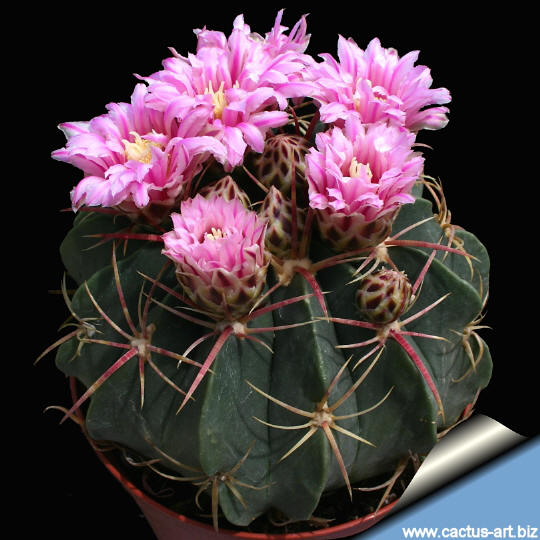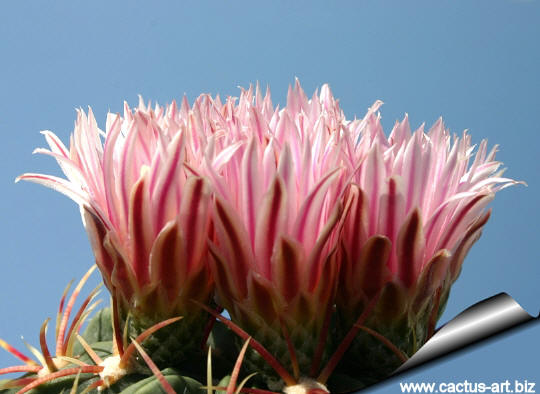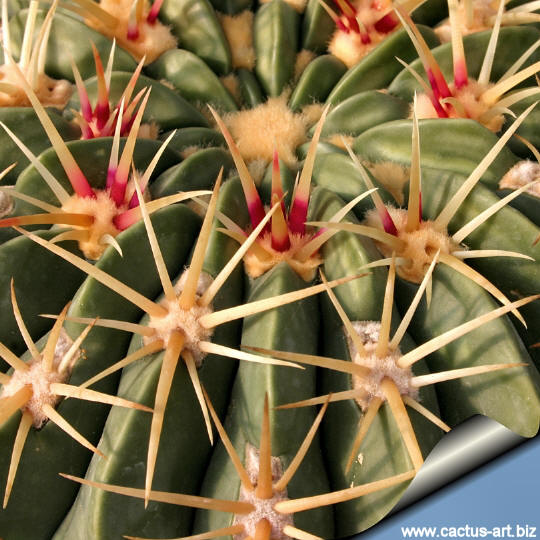|
|
|

Ferocactus macrodiscus
In its habitat it passes the dry periods
almost buried in the ground.
|
|
Description:
Medium sized barrel cactus with a blue-green epidermis.
Stem: Flat, solitary 30cm of diameter (but up to nearly 60 in
some cases)
Ribs: 16 to 21.
Areoles: 5 to 10 mm long with yellow felt.
Spines: Yellow or red and curved.
Central spines: 1 to 4, up to 3,5 cm long.
Radial spines: 6 to 8, 2 cm long.
Flowers: Bright purple/pink and white striped of about 4 cm of
diameter
Blooming season: From early spring into summer .
- The 'macrodiscus' subspecies has
a blue-green epidermis and areoles 0,5 to 1 cm long. The spines are
yellow or red and curved. It is the most prevalent.
- The 'septentrionalis' has a
greenish-yellow epidermis and the areoles are 1,5 to 2,5 cm long. The
spines are straight and strong.
|
|

|
 |
|
Cultivation:
Slow growing to start, but it does well under cultivation. Suited for
any rich, well drained soil (Ph 6). Grow it in full sun throughout the
year. In winter keep completely dry at 10°C, but it can tolerate
sporadic light frost. Anyhow it's problematic if the temperature goes
below 5° with high humidity during the winter rest. Even adult specimens
are affected by wounded spots in their epidermis. It takes less watering
than the standard for other ferocacti.. It's necessary to be avoid
wetting the bodies of these plants while they are in sunlight. A wet
cactus in the sun light can cause sun burning, which can lead to scars,
or even fungal infections and death. It is apt to undergo attacks of
red spiders if it is placed near fruit trees.
Propagation:
Seeds are the only way of
reproducing.
|
|
 |
 |
|
 |
 |
USE: F. macrodiscus
(The "Candy cactus") is
used to make sweets. The middle is cored out and soaked in sugar, then
chopped up and eaten.
|
|


Advertising
|
|
|
|
Family:
Cactaceae (Cactus
Family)
Scientific name:
Ferocactus macrodiscus
Origin:
Mexico (San Luis Potosi, Guanajuato, Oaxaca,
Puebla, Queretaro de Arteaga)
Habitat: Grows in association with Tillandsia usneoides,
bushes and desert trees in a very dry area.
During drought periods the
plants sink well into the ground, from the effects of heat and
dryness. For this reason it is very difficult to
locate the cactus until the rains arrive and it swells itself and
prepares to bloom. If it is not flowering, it would be difficult to see
it
at all.
Conservation status: Listed in
CITES appendix 2.
Synonyms:
- Ferocactus macrodiscus ssp. macrodiscus
(Torr. & Grant) Britton & Rose
- Echinocactus macrodiscus
- Bisnaga macrodisca

|
|
|
|
Unusual in Collections it starts blooming when the
plant has only a diameter of 8-12 cm.



Photo of conspecific taxa, varieties, forms and
cultivars of Ferocactus macrodiscus.
|
|